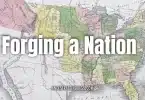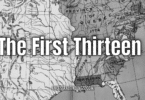America didn’t just stop at thirteen colonies. As time went on, the nation kept growing, stretching further west, taking in vast new territories, and shaping them into states. Some were added because of war, others through political negotiations, and a few took decades to achieve statehood. Their names reflect this history—some rooted in Native American languages, others tied to European explorers, and a few even made up along the way.
In this final part of the series, we start with West Virginia, a state born out of the Civil War, and make our way to Hawaii, a former kingdom that became the 50th star on the U.S. flag. Each name tells a story, revealing how America became what it is today.
West Virginia (1863)
West Virginia’s name is straightforward. It split from Virginia during the Civil War when the western counties opposed secession. While Virginia joined the Confederacy, West Virginia stayed with the Union and was officially made a state in 1863.
But why “Virginia” at all? That name goes all the way back to Queen Elizabeth I, who was called the “Virgin Queen.” So even though West Virginia broke away politically, it still kept its connection to its colonial roots.
Nevada (1864)
Nevada’s name comes from the Spanish word nevada, meaning “snow-covered,” a reference to the Sierra Nevada mountain range.
Nevada’s statehood was rushed through by President Lincoln in the middle of the Civil War because he needed more Union votes in the 1864 election. So, in a way, the Silver State was born out of politics. These days, people think of deserts and Las Vegas when they hear “Nevada,” but its name still ties back to the snowy mountains that helped define its landscape.
Nebraska (1867)
Nebraska’s name comes from an Otoe word, Ni Brasge, meaning “flat water,” referring to the Platte River that runs through the state.
Before it became a state, Nebraska was open prairie land, a key stop for pioneers heading west. But when the Homestead Act of 1862 offered free land to settlers, people rushed in to farm the rich soil, making Nebraska one of the agricultural powerhouses of the country.
Colorado (1876)
Colorado’s name comes from the Spanish word colorado, meaning “colored” or “ruddy,” probably describing the reddish soil and rock formations found in parts of the state.
Colorado became a state in 1876—the 100th anniversary of the Declaration of Independence—so it’s known as the Centennial State. It was also a major destination during the Pike’s Peak Gold Rush, which drew thousands of fortune seekers to the Rocky Mountains.
North & South Dakota (1889)
Both Dakotas get their names from the Dakota Sioux, one of the dominant Native American groups in the region. The word Dakota means “allies” or “friends.”
Originally, there was just one large Dakota Territory, but when statehood came, it was split into two. President Benjamin Harrison shuffled the paperwork before signing, so no one knows for sure whether North Dakota or South Dakota was admitted first.
Montana (1889)
Montana’s name comes from the Spanish word montaña, meaning “mountain,” which makes sense given the state’s rugged landscape.
It was a land of fur trappers, Native American tribes, and later, gold miners hoping to strike it rich. Even today, Montana is known for its wide-open spaces, towering peaks, and untamed wilderness.
Washington (1889)
Washington is the only state named after a U.S. president—George Washington. It was originally part of the Oregon Territory, but settlers wanted their own identity and chose to honor the nation’s first leader.
Despite its name, Washington’s history is shaped by Native American cultures, early European traders, and later, waves of Asian immigration. Over time, it became a hub for timber, aerospace, and eventually, technology.
Idaho (1890)
Idaho’s name is… well, a little bit of a mystery. Early reports claimed it came from a Native American word meaning “gem of the mountains,” but later, historians realized that no such word existed. It turns out that a politician may have made it up!
Even though the name might not have real roots, Idaho has certainly lived up to its legendary status—with beautiful mountains, vast wilderness, and, of course, potatoes.
Wyoming (1890)
Wyoming’s name comes from a Lenape word meaning “large plains.” Originally, it was the name of a valley in Pennsylvania, but later, it was applied to the Wyoming Territory.
It became known for its cowboy culture, its vast open land, and its role in history—Wyoming was the first state to give women the right to vote.
Utah (1896)
Utah’s name comes from the Ute people, a Native American tribe whose name likely means “people of the mountains.”
Utah had a long road to statehood, mostly due to tensions between the U.S. government and the Mormon settlers who had established their own community there. It wasn’t until the Church of Jesus Christ of Latter-day Saints renounced polygamy that Utah was finally admitted as a state.
Oklahoma (1907)
Oklahoma’s name comes from the Choctaw words okla (people) and humma (red), meaning “red people.” It was chosen to honor the Native American tribes who were forcibly relocated there during the Trail of Tears.
Before it became a state, Oklahoma was known as Indian Territory. Then came the famous Land Rush of 1889, when settlers raced to claim land that had previously belonged to indigenous nations.
Arizona (1912)
Arizona’s name likely comes from a Spanish version of a Tohono O’odham word meaning “place of the small spring.”
It was originally part of Mexico before being ceded to the U.S. after the Mexican-American War. Today, Arizona is famous for the Grand Canyon, its desert landscapes, and its deep Native American history.
New Mexico (1912)
New Mexico’s name comes from Nuevo México, the name Spanish explorers gave the region long before the modern country of Mexico even existed.
It has one of the longest histories of continuous human habitation in the U.S., with pueblos and indigenous communities dating back thousands of years.
Alaska (1959)
Alaska’s name comes from the Aleut word Alyeska, meaning “great land.” It was purchased from Russia in 1867, a move that many Americans mocked as “Seward’s Folly.” But after the discovery of gold and oil, Alaska quickly proved its worth.
Today, it’s known for its rugged landscapes, harsh winters, and vast wilderness.
Hawaii (1959)
Hawaii’s name comes from the Polynesian word Hawaiki, referring to a legendary homeland in Polynesian culture.
Originally an independent kingdom, Hawaii was annexed by the U.S. in 1898 before officially becoming the 50th state. It remains one of the most unique places in the U.S., rich with indigenous culture and history.
With the admission of Alaska and Hawaii in 1959, the United States reached its final form. These last states, just like the first thirteen, tell the story of exploration, expansion, and identity. Some names reflect Native American heritage, while others honor pioneers and even fictional stories.
That wraps up the journey through all 50 state names. The next time you look at a map, you’ll know that behind each name is a piece of history waiting to be told.






